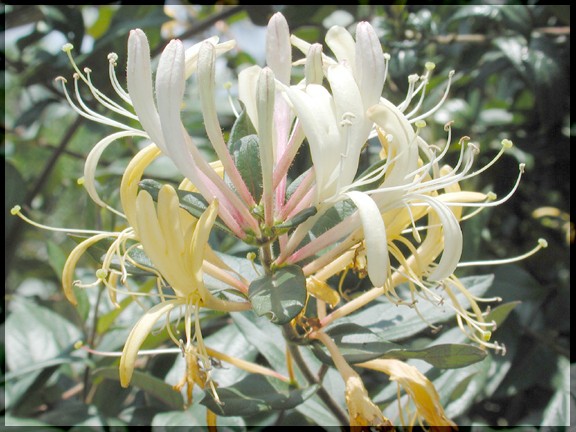Japanese honeysuckle
(Lonicera macrantha)

Description
Lonicera japonica, known as Japanese honeysuckle and golden-and-silver honeysuckle, is a species of honeysuckle native to eastern Asia. It is often grown as an ornamental plant, but has become an invasive species in a number of countries. Japanese honeysuckle is used in traditional Chinese medicine. Lonicera japonica is a twining vine able to climb up to 10 m (33 ft) high or more in trees, with opposite, simple oval leaves 3–8 cm (1.2–3.1 in) long and 2–3 cm (0.79–1.18 in) broad. When its stems are young, they are slightly red in color and may be fuzzy. Older stems are brown with peeling bark, and are often hollow on the inside. The flowers are double-tongued, opening white and fading to yellow, and sweetly vanilla scented. The fruit, which is produced in fall, is a black spherical berry 3–4 mm (0.12–0.16 in) diameter containing a few seeds. While the nectar from the flowers can be safely consumed by humans, all other parts of the plant have the potential to be toxic. Even though it is a highly invasive, and destructive plant, this species is often sold by American nurseries as the cultivar 'Hall's Prolific' (Lonicera japonica var. halliana), and in the UK as the cultivar 'Halliana'. The cultivar is also known as Hall's Japanese honeysuckle. It is an effective groundcover and has strong-smelling flowers. It can be cultivated by seed, cuttings, or layering. In addition, it will spread itself via shoots if given enough space to grow. The variety L. japonica var. repens has gained the Royal Horticultural Society's Award of Garden Merit. Japanese honeysuckle flowers are edible to humans and appreciated for their sweet-tasting nectar. The flowers can also be a significant source of food for deer, rabbits, hummingbirds, and other wildlife.
Taxonomic tree:







